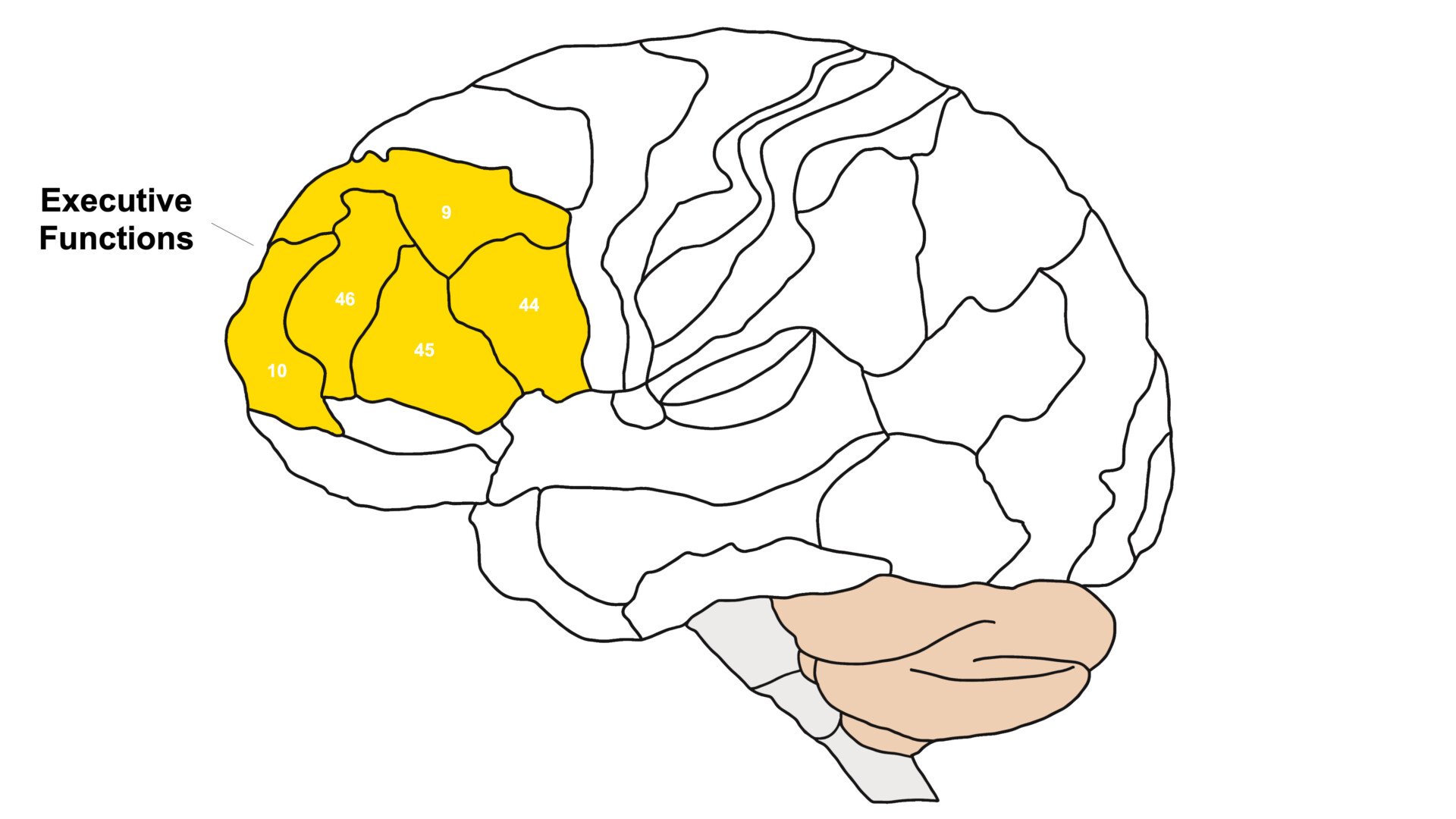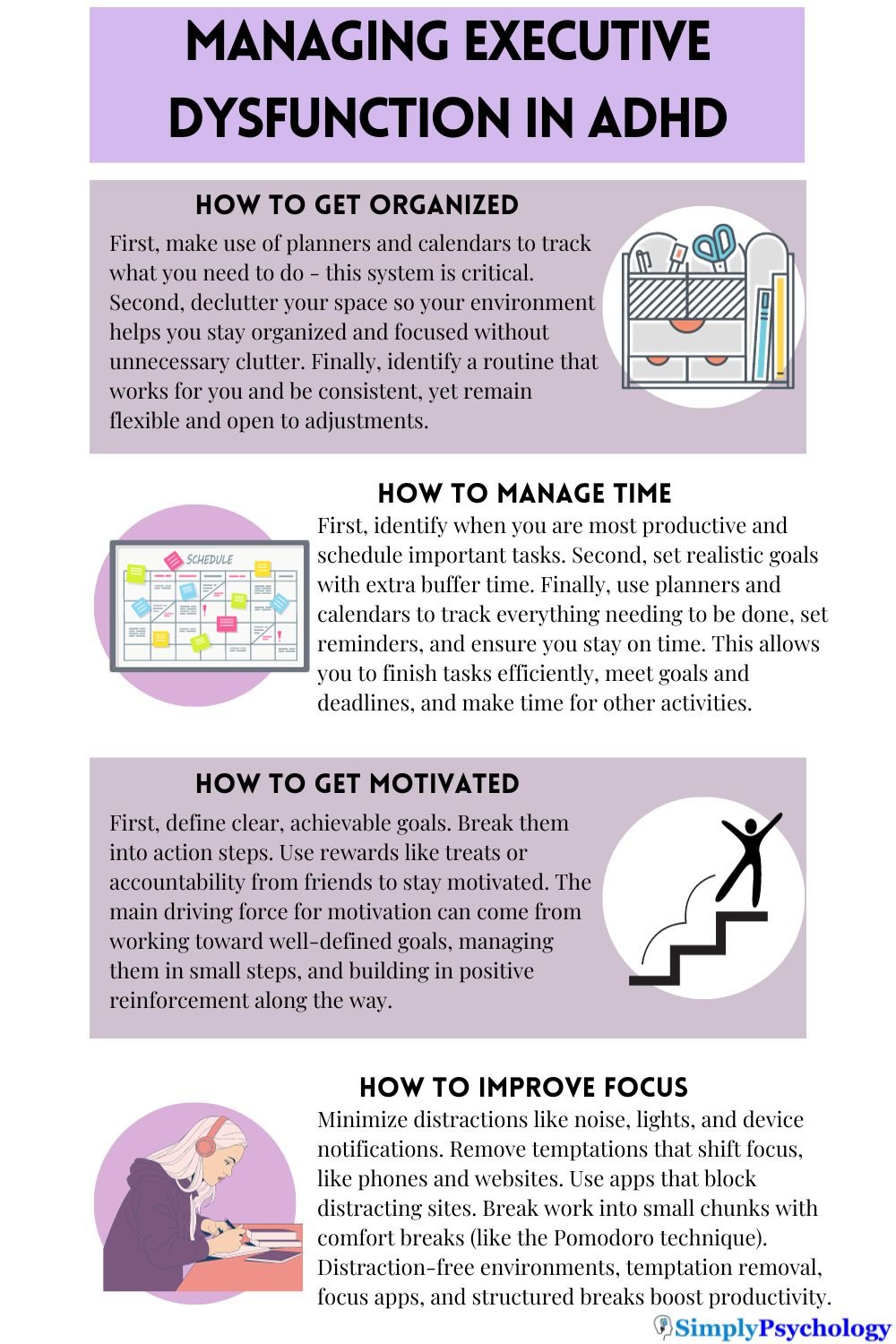Individuals with ADHD may often struggle with processes such as organizing tasks, maintaining focus, regulating emotions, retaining instructions, and successfully completing projects.
These challenges can arise from brain differences in executive function processes, which impact areas like working memory, attention, self-monitoring, and impulse control.

What is executive function?
There are several definitions used to describe executive function but in essence, it is a set of processes happening in the brain that directly affect our cognition (thoughts), emotions, motor skills (movements), verbal skills (language), and behaviors (Eslinger, 1996).
As we can see, it involves several crucial skills that help us express ourselves and navigate the world.
Neurobiologically, an area of the brain called the prefrontal cortex (PFC) is often discussed concerning executive function due to its crucial role in moderating a lot of associated actions (Funahashi & Andreau, 2013).
You can think of the PFC as a hub where lots of executive function-related activity is happening. That being said, the brain is rather interconnected, so executive function processes also happen outside of the PFC.
Some examples of processes stemming from executive function are:
- Working Memory – Retention and manipulation of information temporarily in the mind, e.g., navigation
- Planning and Organization – Ability to set goals, create plans to achieve them, and organize the steps required to do so. It also includes time management and task prioritization.
- Emotional Regulation – Managing emotions, controlling impulsive reactions, and making decisions based on rationality rather than quick-fire actions.
- Impulse Control – Inhibition, resisting distractions, and staying focused on a task or goal, even when faced with competing stimuli or temptations.
- Cognitive Flexibility – Problem-solving, creative thinking, adaptation to changing situations, switching between tasks, and seeing problems from different perspectives.
- Self-monitoring – Keeping track of one’s own performance and behavior, e.g., self-assessing on goal achievement or your social behavior.
The current scientific consensus for ADHD executive function assumes differences and challenges are often a common assumption and hallmark of the condition.
Consequently, people may struggle more to perform certain actions or might need longer to understand certain things, not due to their own fault but as a byproduct of having ADHD.
This can help dispel some myths about ADHD and laziness as people with ADHD can be highly motivated, very creative, have a strong desire to learn, and be quite engaged in interesting or passionate activities.
Signs of Executive Dysfunction In ADHD

ADHD executive function can manifest as several emotional and behavioral responses.
It is important to note that ADHD executive function can manifest differently in people, so this is not a definitive list of signs. Similarly, if you feel like you identify with some of these behaviors, it does not directly mean that you have ADHD.
Consult a professional who specializes in neurodiverse conditions, and they can help answer your questions and perform an official assessment.
Here are some of the most common symptoms to look out for:
Motivation
Individuals with ADHD may struggle with procrastination and remaining engaged and may often postpone them until the last minute. This lack of motivation can be related to difficulties with task initiation and planning.
“For me, it is my tendency to procrastinate and put things off until the last minute. I do think that ADHD restricts you from doing your work.”
From Lawrence (2009)
Additionally, when people do experience periods of intense focus and motivation, this can be inconsistent. This can be especially true for tasks that require ongoing effort.
“I think the hardest aspect is actually going to school, getting there. Once I am there, I am able to do everything just fine. I have had a day or two when I wasn’t motivated to get up. I try not to do that very often.”
From Lawrence (2009)
Inattention and memory
Maintaining attention and concentration for prolonged periods of time is a commonly shared experience for people with ADHD.
This can be particularly enhanced if what they must focus on is deemed boring, uninteresting, or mundane (Fugate & Gentry, 2016). This can be both task-specific and in other instances.
Some examples would be remembering to perform planned actions in the future, such as attending appointments or finishing deadlines, which can lead to missed opportunities, additional stress, and challenges in professional and personal life.
It is also common for someone with ADHD to drift off into space and daydream about other things they find more stimulating, which can make it harder to regain focus.
They may also be performing a task but really struggle to retain information in their memory:
“I know what I’m reading, but it’s not going through … I keep going back and rereading, and kind of forcing myself to notice what that word is and comprehending.”
Ciara (MacNeela, 2016)
Lastly, they are more susceptible to distractions. Even minor environmental stimuli can derail focus from the task at hand, such as loud noises, bright lights, or sudden movements (Ross & Randolph, 2016).
This has direct links to working memory difficulties resulting in forgetfulness, making it challenging to follow multi-step instructions or recall information.
Planning and organizing
Challenges in being organized and well-planned can arise as a byproduct of executive function difficulties and impulsivity. Individuals with ADHD may struggle with deciding which tasks to tackle first, leading to inefficient use of time.
Oftentimes, people with ADHD may also experience difficulties maintaining structure and upholding routines and can find it challenging to organize and prioritize tasks. This can lead to procrastination (Bolden & Fillauer, 2020) and overall increased stress about daily life activities.
“the starting things, never finishing them. Again, chaos. Tidying … The sequence of events. How do I even go about it? … I know when I’d go back to something, I’d miss bits, you know… I never get that click feeling that, I know that was right.… It’s like a sense of a door shut. You know it’s closed properly by, it makes that noise.”
Aoife (MacNeela, 2016)
This struggle to multitask, prioritize, and complete tasks effectively can often lead to feelings of being overwhelmed and difficulty focusing on any single element.
Lastly, time management and time blindness issues are common in people with ADHD, with them often underestimating or overestimating the time needed to complete tasks, causing scheduling conflicts or missed deadlines.
Socializing
Social difficulties are another common consequence of ADHD executive function challenges. For example, social cues may be missed, important anniversaries may be forgotten, or people who know the person with ADHD may feel they are not being given quality time due to them frequently becoming distracted.
Consequently, rifts may begin to form, which can lead to misunderstandings or even conflicts. Disagreements may also arise if impulsive behaviors become risky, e.g., gambling addiction.
Lastly, ADHD-related impulsivity in social situations can also manifest, e.g., individuals may speak without thinking, interrupt conversations, or struggle with turn-taking in group settings.
Individuals with ADHD may also say things that are considered ‘inappropriate’ at the time:
“If I think something’s wrong, I’m quite happy to tell somebody, even though it’s probably not the best time or place. … you fly off the handle I suppose, and you regret it”
Cathal (MacNeela, 2016)
Emotional and impulse control
Challenges with emotional regulation are another common ADHD executive function struggle (Christiansen, Hirsch, Albrecht & Chavanon, 2019).
Due to impulsivity, emotional expressions may be exacerbated above what the situation calls for, with less thought being put into how these outbursts might impact others, making it challenging to regulate emotions. This can lead to mood swings and impulsivity in emotional reactions.
For example, someone with ADHD may find it more difficult to control anger and irritation or struggle to feel centered again after a confrontation.
“I spend a lot of time being afraid of my emotions because I’ll experience something intensely and then be able to get distracted from that emotion and go into being happy or angry really quickly.”
‘Kia’
Enhanced sensitivity to adverse situations such as rejections and arguments is also common, with tendencies to have a negativity bias and interpret ambiguous situations for the worse instead of viewing them from a neutral lens.
Lastly, impulse control issues can extend to various aspects of life, such as spending, eating, and decision-making. Thus, people may have trouble inhibiting immediate desires, even when long-term consequences are unfavorable.
Self Monitoring
ADHD and executive function can affect self-awareness and the ability to self-monitor, making it challenging for individuals to review their own performance and behavior. Consequently, they may not recognize when they are off-task or when they need to adjust their approach.
Such challenges can be seen rather early as well, with observable struggles in self-monitoring noted since childhood (Sluiter, Groen, de Jonge & Tucha, 2020).
This can also directly link to challenges in processing and responding to feedback appropriately. Consequently, people may become defensive or dismissive of feedback, making it difficult to use it for self-improvement purposes.
This self-monitoring can also extend to difficulties with self-control:
“(people with ADHD) have a hard time managing their responses to events and things that come up in their lives… they might have a hard time managing their response to disappointing things that happen in their life, and they may become extremely angry or extremely overwhelmed.”
Dr Karen Wilson, Clinical Neuropsychologist
Impact of Executive Dysfunction
As we have seen, ADHD challenges in executive dysfunction can manifest as various symptoms, meaning that their daily impact also has a wide reach. Let us look at some frequent life areas where executive function challenges materialize.
Academic and Professional Performance
In academic settings, executive dysfunction can result in difficulties in organizing study materials, completing assignments on time, and managing coursework effectively. Students with executive dysfunction may struggle to follow classroom instructions, leading to lower academic achievement.
In the workplace, executive dysfunction can impair job performance. Individuals may have trouble prioritizing tasks, meeting deadlines, and staying organized, hindering career advancement and job satisfaction.
Such challenges can directly stem from executive function difficulties managing time, organization, and forgetfulness and finding it more challenging to remain engaged, focused, and interested.
Mental Health Decline
The emotional toll of executive dysfunction can be significant. Frequent forgetfulness, procrastination, and difficulty meeting goals can lead to feelings of inadequacy and low self-esteem.
People with ADHD are also at an increased risk of developing comorbidities with mental health conditions such as anxiety and depression (Fischer et al., 2007).
Emotional regulation challenges, such as mood swings and impulsive reactions, can further impact mental well-being and interpersonal relationships.
Lastly, struggles with not feeling good or capable enough and heightened sensitivity to criticism and judgment can lead to avoidance behaviors, imposter syndrome, and a negative self-perception.
Long-Term Goals and Life Planning:
Difficulty with goal setting and planning for the future is common as ADHD individuals with executive function may struggle to establish long-term goals, create career plans, or save for retirement.
Oftentimes, difficulties in maintaining structure, upholding routines, and challenges in organizing and prioritizing tasks underlie these tasks, thus making long-term planning challenging.
This can impact your day-to-day living, but prolonged decision-making difficulties can also lead to impulsive choices with long-term consequences, such as financial difficulties or health issues.
In the YouTube video “How to Accomplish Long-Term Projects with ADHD,” the host describes her challenges in this area as follows:
“…short-term projects, and those are just fundamentally easier to plan for, but I have never actually, in retrospect, been successful at a very long-term project because I would lose motivation halfway through, or I would plan it all out, but then something new and shiny would come up, and I would get distracted so completing long-term projects is a challenge for me and for most people with ADHD” (How to ADHD, 2023).
Daily Functioning:
Simple daily tasks, like getting dressed, preparing meals, or paying bills, can become overwhelming for individuals with executive dysfunction.
This can lead to cluttered living spaces, disorganization, taking an excessive amount of time to choose an outfit and even remembering to take medications at the right times or following complex dosing instructions. Thus, these challenges can disrupt daily routines and increase stress.
Maintaining these self-care routines, e.g., exercise or healthy eating, can help provide structure and support individuals in managing their time effectively.
Executive function challenges can then cause disruptions, leading to difficulties in waking up at consistent times, going to bed, or following a daily schedule. As a result, this can affect productivity and overall well-being.
How to manage executive dysfunction
ADHD executive dysfunction challenges can impact several areas of life, so knowing how to manage symptoms can positively affect day-to-day living and interpersonal relationships.
Let us look at some ways you can implement and hopefully cope better with executive dysfunction-related challenges:
How to get organized
Firstly, make use of organization tools such as planners and calendars. This could be electronic or pen and paper, but having a system to track what you need to do is critical.
Secondly, declutter your space. Ensure that your working environment is helping you be organized and focused on the project at hand without any unnecessary items littered in the space.
Lastly, identify a routine that works for you and be consistent. Ensure you stick with your system but remain flexible and open to making adjustments.
How to manage time
Firstly, identify your pique productive days and times and schedule your tasks around that.
Doing work during your most energized times makes you more likely to finish tasks quicker and leave time for other activities.
Secondly, ensure you have set achievable goals and have left enough time to complete them (Modesto-Lowe, Chaplin, Soovajian & Meyer, 2013). A tip might be to incorporate some extra buffer time just in case of unexpected delays.
Lastly, use some form of a planner or organization calendar to note down everything that needs to be done. This way, you can set reminders for things, track your progress, and ensure you are on time.
How to get motivated
Firstly, define clear and achievable goals for yourself, as it can be easier to find motivation if you know what you are striving towards. For example, this can be finishing a work project, learning something new, e.g., drawing, or even cleaning out your space.
Once you have done that, break down these goals into more manageable action steps and incorporate reward systems along the way to keep you going, e.g., a break or having a treat.
Rewards can also come from outside sources, like telling your friends or family and asking them to keep you accountable (Ventouri, 2020). The goal is to use these types of factors as your main driving force for getting motivated.
How to improve focus
Firstly, ensure you minimize any distractions. This can be from the environment, e.g., noise and bright lights, or electronic, e.g., app notifications and messages.
Secondly, remove any temptations. Whether that is looking at your phone, a website, or talking to a colleague, ensure you have nothing around you that may shift your focus.
There are websites and apps available that lock you out of the specific website you chose, e.g., Instagram, for a set amount of time to increase productivity.
Lastly, break down work into smaller chunks and incorporate comfort breaks. The Pomodoro technique might be very beneficial.
Managing ADHD Using CBT Approaches
Research shows that using cognitive-behavioral therapy (CBT) strategies can also be beneficial for addressing executive dysfunction. CBT aims to modify unhelpful thought patterns while teaching behavioral skills.
A core premise of CBT for ADHD is that it represents an “implementation problem” – people with ADHD often know what they need to do, but struggle to consistently put skills into action over time. CBT targets this gap between intentions and actions (Ramsay, 2020).
Specific CBT strategies that can help manage ADHD executive dysfunction include:
- Modifying self-talk to build “self-regulatory efficacy” – the belief in one’s ability to organize and implement steps for change. Focusing on alleviating self-doubt through positive coping statements.
- Breaking down tasks into smaller, manageable steps with clear start and end points. Using checklists, timers, alarms and calendar alerts can facilitate task completion.
- Planning ahead and anticipating challenging situations. Mentally rehearsing upcoming activities and preparing contingency plans if difficulties emerge.
- Practicing mindfulness techniques to train attention and promote cognitive flexibility when faced with frustrations.
- Using external accountability through check-ins with others to motivate follow-through.
- Tracking accomplishments, not just failures. Reviewing progress regularly to enhance self-awareness and self-efficacy.
Executive dysfunction and the ADHD brain
There are notable differences in brain structure and function between individuals with ADHD and those without ADHD, particularly in areas related to executive function. Some of the key differences can be seen in:
Prefrontal Cortex
The prefrontal cortex (PFC) is a critical brain region responsible for executive functions such as decision-making, impulse control, working memory, and attention.

Research has shown that individuals with ADHD often exhibit structural and functional differences in the PFC compared to non-ADHD individuals (Arnsten, 2009). These differences may include reduced volume or activity in this region.
Research has also uncovered notable delays in PFC maturation, reduced volume, and smaller size when comparing ADHD children and non-ADHD children (Friedman & Rapoport, 2015), demonstrating that such structural differences can be observed and begin from a young age.
Frontostriatal Pathways
The communication pathways between the prefrontal cortex and the striatum, which is part of the brain’s reward and motivation system, are vital for executive function. These pathways facilitate the integration of cognitive control and motivation.
Disruptions in frontostriatal pathways can lead to difficulties regulating attention, emotions, and motivation. In ADHD, these pathways may not function optimally, contributing to executive dysfunction (Castellanos & Proal, 2012).
Dopamine Levels
ADHD is also associated with differences in the dopamine system in the brain. Dopamine is a neurotransmitter involved in reward, motivation, and the regulation of attention.
Research suggests that individuals with ADHD may have lower dopamine levels or differences in dopamine receptor sensitivity (Blum et al., 2008).
This lower baseline can influence the ability to sustain attention and motivation for tasks that may not provide immediate rewards. Additionally, it can impact the brain’s response to rewarding stimuli and its ability to regulate motivation and impulsive behaviors.
Brain Connectivity
Functional MRI studies have revealed altered connectivity patterns in the brains of individuals with ADHD (Sato, Hoexter, Castellanos & Rohde, 2012). These differences in connectivity can then impact the coordination of brain regions responsible for executive functions.
The Default Mode Network (DMN), which is associated with mind-wandering, relaxing, and self-referential thoughts, has also been found to have some altered connectivity in people with ADHD (Uddin et al., 2009). This can impact an individual’s ability to stay focused on tasks and suppress distractions.
FAQs
Is executive dysfunction a core symptom of ADHD?
Yes, executive dysfunction is a core symptom of ADHD and significantly contributes to several challenges someone might face (Roth & Saykin, 2004). Some examples include trouble with organizing tasks, maintaining attention, controlling impulses, managing time, and setting and achieving goals.
Severity and symptom presentation among individuals with ADHD can vary, with some experiencing more pronounced difficulties in specific executive functions while others can have a broader range of challenges.
That being said, it is important to note that executive dysfunction can also occur independently of ADHD or as a symptom of other conditions such as Autism Spectrum Disorders (Pugliese, Wallace, Anthony & Kenworthy, 2020), Schizophrenia (Orellana & Slachevsky, 2013), Alzheimer’s disease (Baudic et al., 2006).
What does executive dysfunction feel like?
Executive dysfunction can feel very frustrating and overwhelming. Imagine having a mental roadblock that makes daily tasks and responsibilities a lot more challenging for you in comparison to other neurotypical people.
Some examples of executive dysfunction that one may experience are a sense of disorganization, forgetfulness, feeling overloaded, and difficulty starting or completing tasks. Emotionally, people can experience elevated levels of stress, anxiety, decreased self-esteem, and an overall sense of inadequacy due to struggles in managing their daily lives effectively.
It is important to highlight that executive dysfunction can vary in both its intensity and impact from person to person. Thus, what one person experiences as a significant and important challenge, another may manage more effectively.
What is the difference between ADHD and an executive function disorder?
ADHD and Executive Function Disorder (EFD) are separate conditions that share some overlapping symptoms.
ADHD is a well-defined neurodevelopmental disorder with both core symptoms, such as inattention, hyperactivity, and impulsivity, and broader symptoms, such as organization, emotional regulation, and working memory.
Contrastingly, EFD is a set of cognitive challenges related to skills like organization, time management, and impulse control.
While executive dysfunction is a common feature of ADHD, not all individuals with executive dysfunction have ADHD.
Lastly, EDF is not a standalone diagnosis but rather a term used to describe difficulties specifically related to executive functions, which can occur in various conditions (Papazian, Alfonso & Luzondo, 2006), including ADHD.
What is ADHD paralysis?
ADHD paralysis, sometimes referred to as “analysis paralysis,” is a term used to describe a state in which individuals with ADHD feel overwhelmed by tasks or decisions to the point that they struggle to initiate or complete any of them (Enright, 2021).
Some examples are procrastination, feeling overwhelmed, struggles with time management, and overall reduced productivity. It can occur in various contexts, from choosing what to wear in the morning to making significant life decisions.
ADHD paralysis can be managed with strategies such as breaking tasks into smaller steps, reducing the perceived complexity of decisions, or with therapy and medication if advised.
Can technology be used to help improve executive functioning in people with ADHD?
A recent meta-analysis looked into whether computerized cognitive training programs can help adults with ADHD improve cognitive skills like working memory through regular practice on computer-based mental exercises.
However, the research suggests the benefits of these programs for reducing ADHD symptoms and improving daily functioning are quite limited so far (Elbe et al. 2023).
More study is needed to determine if tailored approaches can help adults manage persistent attention deficits.
References
Arnsten, A. F. (2009). Toward a new understanding of attention-deficit hyperactivity disorder pathophysiology: an important role for prefrontal cortex dysfunction. CNS drugs, 23, 33-41.
Baudic, S., Dalla Barba, G., Thibaudet, M. C., Smagghe, A., Remy, P., & Traykov, L. (2006). Executive function deficits in early Alzheimer’s disease and their relations with episodic memory. Archives of clinical neuropsychology, 21(1), 15-21.
Blum, K., Chen, A. L. C., Braverman, E. R., Comings, D. E., Chen, T. J., Arcuri, V., … & Oscar-Berman, M. (2008). Attention-deficit-hyperactivity disorder and reward deficiency syndrome. Neuropsychiatric disease and treatment, 4(5), 893-918.
Bolden, J., & Fillauer, J. P. (2020). “Tomorrow is the busiest day of the week”: Executive functions mediate the relation between procrastination and attention problems. Journal of American College Health, 68(8), 854-863.
Castellanos, F. X., & Proal, E. (2012). Large-scale brain systems in ADHD: beyond the prefrontal–striatal model. Trends in cognitive sciences, 16(1), 17-26.
Christiansen, H., Hirsch, O., Albrecht, B., & Chavanon, M. L. (2019). Attention-deficit/hyperactivity disorder (ADHD) and emotion regulation over the life span. Current psychiatry reports, 21, 1-11.
Elbe, P., Bäcklund, C., Vega-Mendoza, M., Sörman, D., Gavelin, H. M., Nyberg, L., & Ljungberg, J. K. (2023). Computerized cognitive interventions for adults with ADHD: A systematic review and meta-analysis. Neuropsychology, 37(5), 519–530.
Eslinger, P. J. (1996). Conceptualizing, describing, and measuring components of executive function: A summary.
Enright, J. (2021). ADHD Paralysis Explained. Retrieved May, 22, 2023.
Fischer, A. G., Bau, C. H., Grevet, E. H., Salgado, C. A., Victor, M. M., Kalil, K. L., Sousa, N. O., Garcia, C. R. & Belmonte-de-Abreu, P. (2007). The role of comorbid major depressive disorder in the clinical presentation of adult ADHD. Journal of psychiatric research, 41(12), 991-996.
Friedman, L. A., & Rapoport, J. L. (2015). Brain development in ADHD. Current opinion in neurobiology, 30, 106-111.
Fugate, C. M., & Gentry, M. (2016). Understanding adolescent gifted girls with ADHD: Motivated and achieving. High Ability Studies, 27(1), 83-109.
Funahashi, S., & Andreau, J. M. (2013). Prefrontal cortex and neural mechanisms of executive function. Journal of Physiology-Paris, 107(6), 471-482.
How to ADHD (2023, February 21). How to Accomplish Long Term Projects with ADHD [Video]. YouTube. https://www.youtube.com/watch?v=OEHD8B33-wc
Lawrence, C. N. (2009). Experiences of community college students with ADHD: A qualitative study in the tradition of phenomenology. The University of Nebraska-Lincoln.
MacNeela, P. (2016). Finding your way with ADHD: Struggles, supports, and solutions.
Modesto-Lowe, V., Chaplin, M., Soovajian, V., & Meyer, A. (2013). Are motivation deficits underestimated in patients with ADHD? A review of the literature. Postgraduate medicine, 125(4), 47-52.
Orellana, G., & Slachevsky, A. (2013). Executive functioning in schizophrenia. Frontiers in psychiatry, 4, 35.
Papazian, O., Alfonso, I., & Luzondo, R. J. (2006). Executive function disorders. Revista de neurologia, 42, S45-50.
Pugliese, C. E., Wallace, G. L., Anthony, L. G., & Kenworthy, L. (2020). Understanding executive function challenges in autism spectrum disorder.
Ramsay, J. R. (2020). Rethinking adult ADHD: Helping clients turn intentions into actions. American Psychological Association.
Ross, P., & Randolph, J. (2016). Differences between students with and without ADHD on task vigilance under conditions of distraction. Journal of educational research and practice, 4(1), 1-10.
Roth, R. M., & Saykin, A. J. (2004). Executive dysfunction in attention-deficit/hyperactivity disorder: cognitive and neuroimaging findings. Psychiatric Clinics, 27(1), 83-96.
Sato, J. R., Hoexter, M. Q., Castellanos, X. F., & Rohde, L. A. (2012). Abnormal brain connectivity patterns in adults with ADHD: a coherence study.
Sluiter, M. N., Groen, Y., de Jonge, P., & Tucha, O. (2020). Exploring neuropsychological effects of a self-monitoring intervention for ADHD-symptoms in school. Applied Neuropsychology: Child, 9(3), 246-258.
Uddin, L. Q., Kelly, A. C., Biswal, B. B., Margulies, D. S., Shehzad, Z., Shaw, D., … & Milham, M. P. (2008). Network homogeneity reveals decreased integrity of default-mode network in ADHD. Journal of neuroscience methods, 169(1), 249-254.
Ventouri, E. (2020). ADHD and Learning Motivations. Open Access Library Journal, 7(8), 1-28.



